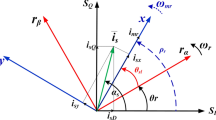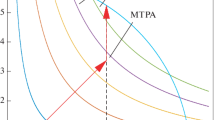Abstract
Rapid change of the rotating speed of an induction motor causes large reaction torque or excessive vibration of the system base. This paper proposes a passive reaction torque compensated (RTC) induction motor considering the dynamic characteristic of open-loop speed control with a variable frequency drive. RTC mechanism converts the reaction torque into the dissipative inertial energy of the rotary stator and the potential energy of the torsion spring torque so that a part of the reaction torque or the spring torque is transmitted to the system base. First, dynamic equation and simulation model for the RTC induction motor are introduced and verified with experiments. The acceleration response of an induction motor with variable speed drive is approximated as first-order ordinary differential equation. Then, the RTC mechanism such as spring and additional inertia are designed considering derived acceleration response or torque profile. Then, an experimental set-up and its control system for the RTC induction motor are built. Finally, effectiveness of the RTC induction motor is verified comparing open-loop speed control of both RTC and conventional induction motor.















Similar content being viewed by others
Abbreviations
- c m, c s, c b :
-
Damping of rotor, stator and system base
- d 0 :
-
Initial deflection of tension spring at balance position
- F :
-
Force caused by tension spring
- i rq, i sq :
-
q-component of rotor and stator current
- J m, J s, J b :
-
Inertia of rotor, stator and system base
- K :
-
Stiffness of tension spring
- k s, k b :
-
Stiffness of equivalent stator and system base springs
- L 0 :
-
Undeformed length of tension spring
- L m, L r :
-
Magnetizing and rotor inductance
- p :
-
Number of poles
- R :
-
Distance from center of motor to pin of attached spring
- R r :
-
Rotor resistance
- r :
-
Radius of the pins
- T e, T L :
-
Motor and load torque
- T ks :
-
Torque generated by spring between stator and base
- T Trans :
-
Transmitted torque to the system base
- γ m :
-
Rotor acceleration
- η m, τ m :
-
Motor constants
- λ rd :
-
d-component of rotor flux
- θ m, θ s, θ b :
-
Rotary angle of rotor, stator, system base
- ω :
-
Frequency
- ω d, ω m :
-
Rotating flux and rotor speed
References
E. Levi, Advances in converter control and innovative exploitation of additional degrees of freedom for multiphase machines. IEEE Trans. Industr. Electron 63(1), 433–448 (2016)
I. Shin, J. Lee, J.Y. Lee, K. Jung, D. Kwon, B.D. Youn, H.S. Jang, J.-H. Choi, A framework for prognostics and health management applications toward smart manufacturing systems. Int J Precis Eng Manuf GT 5(4), 535–554 (2018)
N. Grossi, Accurate and fast measurement of specific cutting force coefficients changing with spindle speed. Int J Precis Eng Manuf 18(8), 1173–1180 (2017)
S.B. Shim, Y.J. Park, J.S. Nam, S.C. Kim, J.M. Kim, K.U. Kim, Development of a rotary clap mechanism for positive displacement rotary pumps: pump performance analysis. Int J Precis Eng Manuf 18(4), 575–585 (2017)
C.T. Raj, S.P. Srivastava, Energy efficient control of three-phase induction motor—a review. Int J Comput Electr Eng 1(1), 1793–1898 (2009)
N. Lang, T. Cookson, E. Thorton, Adjustable speed drives applied to large AC induction motor and pump systems. in Proceedings of the 24th International Pump Users Symposium, (2018), pp. 75–80
Y.H. You, H.-J. Ahn, A passive reaction force compensation (RFC) mechanism for a linear motor motion stage. Int J Precis Eng Manuf 15(5), 797–801 (2014)
H.-J. Ahn, Eddy current damper type reaction force compensation mechanism for linear motor motion stage. Int J Precis Eng Manuf-Green Tech 3(1), 67–74 (2016)
D.C. Nguyen, H.-J. Ahn, A fuzzy-P controller of an active reaction force compensation (RFC) mechanism for a linear motor motion stage. Int J Precis Eng Manuf 16(6), 1067–1074 (2015)
D.C. Nguyen, H.-J. Ahn, Semi-active reaction force compensation for a linear motor motion stage. Int J Precis Eng Manuf 17(7), 857–862 (2016)
K.D. Hoang, H.-J. Ahn, Both energy and cost-effective semi-active RFC (reaction force compensation) method for linear motor motion stage. Int J Precis Eng Manuf-Green Tech 4(1), 73–78 (2017)
W.L. Carlson Jr. (1982) Torque compensated electric motor, US4373147A
G. Atlas, Mechanical stabilization system with counter-rotating nested rotors, US5012170A (1990)
S. Sugita, M. Tomizuka, Cancellation of unnatural reaction torque in variable-gear-ratio. J Dyn Sys Meas Cont 134(2), 021019(1–10) (2012)
C. Ishii, G. Komada, Estimation of reaction torque and compensation for elongation of wire for wire actuated robotic forces. in Proceedings of 19th World Congress The IFAC 47(3) (2014), pp 7233–7238
A.G. Pratt, M.M. Williamson, Series elastic actuators. Proc IEEE/RSJ Int Conf Int Robots Syst 1995, 399–405 (1995)
J. Hurst, A. Rizzi, D. Hobbelen, Series elastic actuation: potential and pitfalls. in International conference on climbing and walking robots (2004)
C. Lee, S. Kwak, J. Kwak, S. Oh, Generalization of series elastic actuator configurations and dynamic behavior comparison. Actuators 6(26), 1–26 (2017)
D.C. Nguyen, H.-J. Ahn, Dynamic analysis and iterative design of a passive reaction force compensation device for a linear motor motion stage. Int J Precis Eng Manuf 15(11), 2367–2373 (2014)
N. Mohan, Advanced electric drives—analysis (Control Model Simulink, MNPERE, 2001)
Author information
Authors and Affiliations
Corresponding author
Rights and permissions
About this article
Cite this article
Hoang, MH., Ahn, HJ. RTC (reaction torque compensated) induction motor and its open-loop control. JMST Adv. 1, 23–30 (2019). https://doi.org/10.1007/s42791-019-0017-x
Received:
Revised:
Accepted:
Published:
Issue Date:
DOI: https://doi.org/10.1007/s42791-019-0017-x




